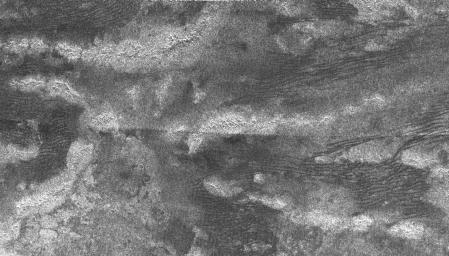
|
Tectonic Features
- Click the image above for a larger view
- Full-Res JPEG (1138 x 649) (235.7 kB)
- Full-Res TIFF (1138 x 649) (739.5 kB)
Caption:
This synthetic aperture radar image of Titan was taken on Oct. 28, 2005, as the Cassini spacecraft flew by at a distance of 1,350 kilometers (840 miles). This was the first pass dedicated to radar, and it was the fourth time Cassini's radar honed in on the smoggy moon.
The bright, curving features are high-standing ridges, poking up above the plains of Titan. Some of the ridges extend for over 100 kilometers (60 miles). They are likely to be tectonic in origin, formed by deformation of Titan's icy crust. The low-lying terrain between the ridges is covered in dark streaks, which could be dunes formed by wind. The streaks, spaced 1 to 2 kilometers apart (0.6 to 1 mile), curve between patches of the bright terrain, which probably act as topographic barriers.
This image is 400 kilometers (250 miles) across and 275 kilometers-wide (170 miles). It is located 8 degrees south latitude and 215 degrees west longitude.
Background Info:
The Cassini-Huygens mission is a cooperative project of NASA, the European Space Agency and the Italian Space Agency. The Jet Propulsion Laboratory, a division of the California Institute of Technology in Pasadena, manages the mission for NASA's Science Mission Directorate, Washington, D.C. The Cassini orbiter was designed, developed and assembled at JPL. The radar instrument team is based at JPL, working with team members from the United States and several European countries.
For more information about the Cassini-Huygens mission visit http://saturn.jpl.nasa.gov .
Cataloging Keywords:
| Name | Value | Additional Values |
|---|---|---|
| Target | Titan | |
| System | Saturn | |
| Target Type | Satellite | |
| Mission | Cassini-Huygens | |
| Instrument Host | Cassini Orbiter | |
| Host Type | Orbiter | |
| Instrument | Radar Mapper | |
| Detector | ||
| Extra Keywords | Dune, Grayscale, Radar | |
| Acquisition Date | ||
| Release Date | 2005-11-01 | |
| Date in Caption | 2005-10-28 | |
| Image Credit | NASA/JPL-Caltech/ASI | |
| Source | photojournal.jpl.nasa.gov/catalog/PIA03566 | |
| Identifier | PIA03566 | |
